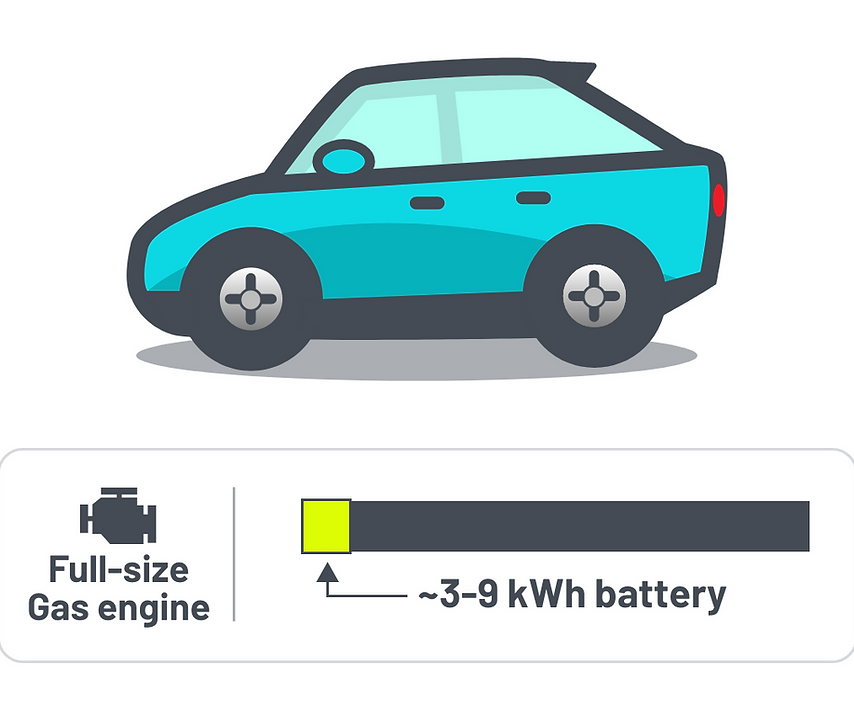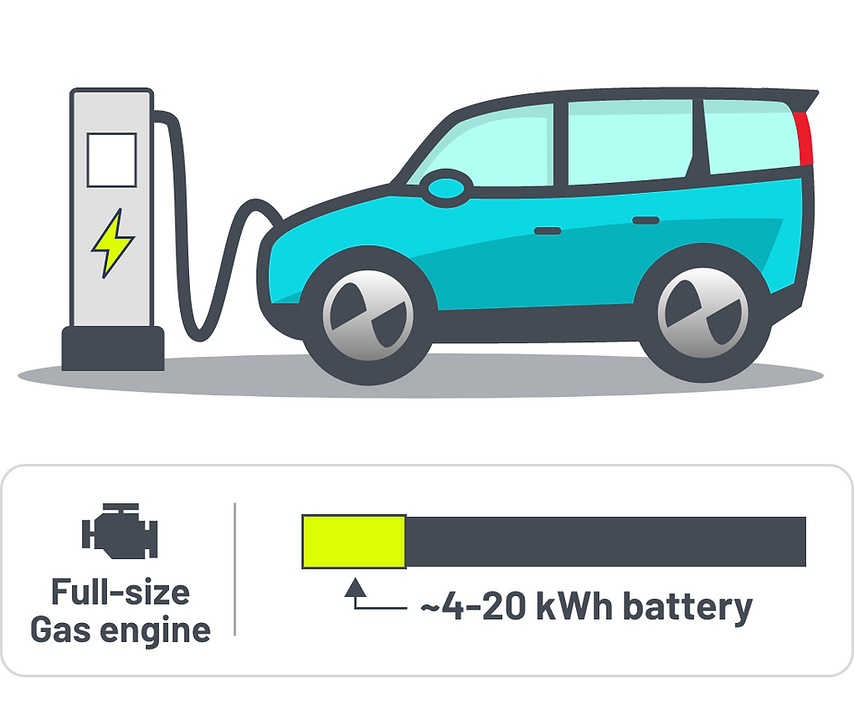
Imagine for a moment, a spectrum. On one side, there’s a car that runs entirely on gasoline. On the other side, there’s a car that runs entirely on batteries. In the middle there are cars that use some combination of both, but each do so differently, and to varying degrees.
In trying to determine which of these might fit your life best, it’s important to understand how each works, along with the advantages and disadvantages of each. Let's jump in.
The cars on this spectrum all use some combination of the following components:

Some cars use a bigger gas engine and smaller battery, others a bigger battery and smaller gas engine. Battery sizes vary wildly, depending on whether or not there's a gas engine and the output of that engine. Some require a plug to recharge the battery, and all deploy the power available in different ways. Overall there are 5 types of electrified vehicle worth covering here. Let's take a look at each.

Mild Hybrids are the least electrified vehicle on this spectrum. Simply put, a Mild Hybrid is a gas vehicle that drives the wheels using gasoline 100% of the time. So what's the point of the battery then? The battery power assists the operation of the gasoline engine, so that it doesn't have to work as hard. Think of it like a gentle push for the car already in motion. A Mild Hybrid is the only vehicle on this spectrum that cannot power the wheels on battery power alone.
A Mild Hybrid uses a small electric motor & battery to assist an otherwise normal gas engine. Driving one feels just like a regular gas car.
A Mild Hybrid has the ability to automatically start or stop the gas engine while idling, like when you’re sitting at a stoplight. As soon as you lift your foot off the brake pedal, the gas engine restarts and is ready to accelerate.
A Mild Hybrid is NOT able to drive on battery power alone. The electric components can only mildly assist the gas engine that's already in motion, so that it doesn’t have to work quite as hard (which saves you fuel).
Many automakers are including Mild Hybrid systems in cars that most people aren’t even aware of. You might already be driving one! These systems are becoming more common especially in large vehicles like trucks and SUVs.
If you just don’t want to think about any of this, and you would rather your car work like the gas cars we’ve all driven for years, a Mild Hybrid might be your best option. It will also be the least efficient option on this list, and avoids most of the key benefits of electrification.
But you're not here because you were interested in barely electric cars, so let's move on...

Otherwise known as a "Full Hybrid" or “Self-Charging Hybrid”, these cars use both gasoline and battery power to drive the wheels, and will intelligently switch back and forth between the two. Full Hybrids still have very small batteries, so they can only drive (very) short distances on battery power before the gas engine takes over. The good news is, a Full Hybrid can charge its small battery as you drive through a process called Regenerative Braking (more on this later). When the battery has regained enough power to be helpful, the car will use it. The driver doesn't have to think about any of this, the car will manage when gas or battery is used automatically.
A Full Hybrid still uses a very small electric motor and battery to assist a gasoline engine, but these cars can also drive short distances using electric power alone.
Full Hybrids are able to recharge their small batteries using recaptured energy as they drive. The car is constantly deciding whether it wants to use electric power or gasoline power. The driver doesn’t have to think about any of it.
It’s hard to believe, but these hybrids have been around now for over 25 years! Cars like the Toyota Prius popularized the technology, and they’ve proven themselves remarkably reliable over that time.
Hybrids have a reputation for being a bit of a snooze. For years, these cars were optimized for efficiency and not particularly exciting to drive. That’s changing with modern hybrids, which can be powerful and even thrilling. Even Formula 1 race cars use hybrid technology now, employing battery power when they need a speed boost!
Those who want the most efficient option without having to worry about plugging their car in. If you live in a place without a plug, like an apartment complex, or if you drive long daily distances frequently (as in, hundreds of miles per day) and don't want to deal with charging-on-the-go, a Full Hybrid might be the best option for you.

Perhaps the truest compromise between electric and gasoline powertrains, Plug-In Hybrids give meaningful all-electric range before switching to the gasoline engine and driving like a gasoline car. While it might seem like a Plug-In Hybrid is the best of both words, it really depends on how you drive it.
A Plug-In Hybrid generally has a bigger battery than Full or Mild Hybrids. This means the car can drive useful distances on electric power alone (depending on the car, between 15 and 50 miles per charge). That might not seem like very much range, but remember that on average, Americans drive 29 miles per day. Many PHEVs offer enough EV range to get through most of your daily driving without using gas (or using a lot less of it).
Plug-In Hybrids are meant to be charged often - whether that’s at home every night, at work every day, or regularly with public charging stations. It’s easy to understand why - these cars offer EV range for a short but useful distance before they switch to their gas engine and operate more like a Full Hybrid. The more often you charge, the less gas you use.
Thanks to their bigger batteries, Plug-In Hybrids are often heavier than equivalent Full Hybrids. After the initial charge is depleted, Plug-In Hybrids are often less efficient than a Full Hybrid would be under the same conditions. For this reason, if you’re someone who drives long distances often (like hundreds of miles per day) or someone who is not able to charge your Plug-In Hybrid daily, than a Full Hybrid might be the more efficient choice for your habits.
Those who can charge frequently (ideally at home) and want the benefits of an EV, but are not ready to give up the conveniences of a gas car for longer trips. Keep in mind that for buyers who are not able to charge regularly, a Full Hybrid may be more efficient. For those who CAN charge at home, a fully electric car may work just fine. So Plug-In Hybrids actually serve a much smaller group in the middle.

Extended Range EVs are almost a fully-electric car, but they still have a small gas engine that works as a generator (to charge the batteries) instead of propulsion.
Extended Range EVs are a weird category. You can think of them like electric cars that have a gas generator on board. The gas engine may be significantly smaller than normal (the BMW i3, for example, uses a modified scooter engine under the rear cargo floor) and the gas engine generally doesn’t propel the car. Instead it’s used to recharge the batteries as you drive, while the batteries and electric motor do the work of propelling the car.
You should treat these cars like electric cars in the sense that they’re meant to be charged at home and/or on the go. The gas is generally a backup plan in case you’re in a bit of a jam and not able to charge.
In 2022, Extended Range models are quite rare. In fact, all have been discontinued (but are available on the used market). This is a bit of an experimental category, with each car operating uniquely. More Extended Range models are due in the coming years, and we expect that this will continue to be a unique and somewhat quirky category.
Those who want the benefits of an EV but are not ready to give up the conveniences of a gas car. To buy an Extended Range EV you should be able to charge daily at home or work, and do most of your daily driving locally (generally less than 100 miles per day). Longer trips are infrequent, and you are willing to charge on the go as if you had a full electric car (but want the gasoline as a "safety net" in the rare cases when you’re not able to).

Ever wonder what it feels like to forget the price of gas? A BEV is the full electric car that untethers you from petrol completely.
Believe us, it’s a wonderful feeling to have no idea what the price of gas is. BEV is a fully electric car and with it, you’re swapping the gas pump for the charging station full time.
A big part of buying an electric car is choosing the right battery size, with an EV range that fits your needs. With a few exceptions, EVs in 2022 generally have at least 150 miles of range, with the longest range models closer to 450 miles.
Since this is the only car on this list that MUST be charged to get to where you’re going, it’s critical that you know how and where to charge one. We’re going to have a whole lesson on charging because there are different types of charging stations, with different connectors, that charge at different speeds, all on different charging networks, and if none of that makes sense right now we understand but we’ll cover all of it in the next lesson.
There are so many benefits to driving an EV, we’re going to need a whole chapter to cover them. For now suffice it to say that EVs have more torque, need less maintenance, and have inherent advantages when it comes to safety, interior volume, connected convenience features and of course, the environment.
Those who are ready to leave gasoline behind, and adopt a slightly new lifestyle. You will be able to charge at home or work daily, OR be willing to put up with the inconveniences of charging regularly on the go. If you take long trips, you’re confident that there are charging stations along the routes that you want to drive, and the car you choose is compatible with those plugs. You’re willing to charge while on the go, which might mean allowing yourself more time to get to your destination.